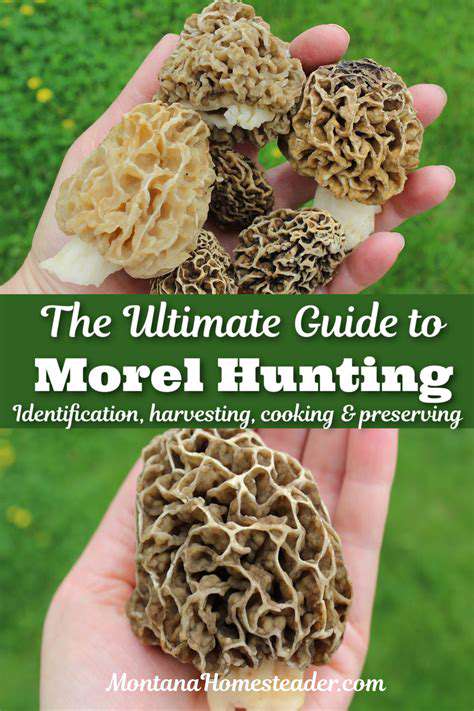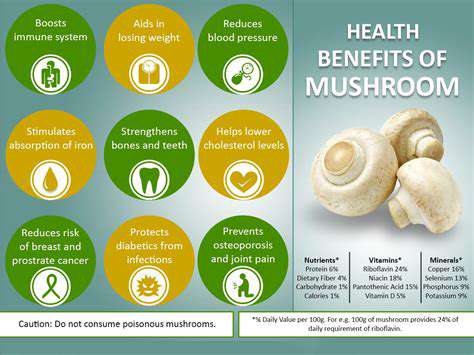Types of Mushrooms and How to Use Them
Beyond the Button: Exploring the Versatility of Cremini
Cremini mushrooms offer an earthy depth that button mushrooms simply can't match. Their firm texture makes them ideal for dishes where structure matters - think hearty stews or roasted vegetable medleys. What really sets creminis apart is their ability to add savory complexity without overpowering other ingredients. For home cooks looking to elevate their mushroom game, these fungi present the perfect transitional option.
The Delicate Delight of Oyster Mushrooms
Oyster mushrooms bring an elegant touch to any meal with their delicate fronds and subtle sweetness. Their quick cooking time makes them perfect for busy weeknights, while their unique texture adds visual interest to simple stir-fries. These mushrooms have an almost magical ability to soak up flavors from marinades and sauces, transforming them into flavor-packed morsels that complement everything from Asian-inspired dishes to rustic pizzas.
The Earthy Elegance of Shiitake
Shiitake mushrooms deliver an unmistakable umami punch that chefs and home cooks alike treasure. Their robust character stands up beautifully in Asian soups and noodle dishes, while their meaty texture makes them satisfying in vegetarian preparations. Nutritionally, shiitakes pack an impressive array of vitamins and minerals, making them as good for your health as they are for your taste buds.
The Forest Floor's Bounty: Chanterelles
Chanterelles offer a taste of the wild with their golden hue and distinctive aroma. These seasonal treasures shine when prepared simply - a quick sauté in butter allows their natural nuttiness to take center stage. Their fleeting availability makes each chanterelle dish feel like a special occasion, perfect for impressing guests or treating yourself to something extraordinary.
The Mighty Morel: A Springtime Treasure
Morels arrive like clockwork each spring, their honeycombed caps signaling the season's change. Their complex flavor profile - equal parts earthy and subtly fruity - makes them worth the hunt. These mushrooms transform simple preparations into gourmet experiences, whether folded into creamy sauces or featured in elegant omelets.
The Adventurous Explorer's Choice: Lion's Mane
Lion's mane mushrooms challenge expectations with their unique texture and delicate seafood-like notes. Their brain-like appearance makes them conversation starters, while their mild flavor makes them versatile in the kitchen. For those seeking new culinary experiences, lion's mane offers exciting possibilities from vegan crab cakes to rich mushroom bisques.
Portobello Power: A Versatile Vegetarian Staple
Portobellos have earned their place as vegetarian favorites thanks to their substantial size and meaty texture. Their large caps become perfect vessels for stuffings or stand-in burgers, while their rich flavor holds up to bold marinades. When grilled, portobellos develop an irresistible smoky depth that satisfies even dedicated meat lovers.
Cultivation and Harvesting: Tips for Safe Mushroom Hunting and Selection

Preparing the Soil
Successful mushroom cultivation begins with careful soil preparation. Soil testing reveals crucial information about nutrient levels and pH balance, allowing growers to create ideal growing conditions. The process involves analyzing existing soil composition and making necessary amendments with organic matter like compost. Proper soil structure ensures adequate drainage while retaining sufficient moisture - both critical factors for healthy fungal growth.
Cultivation Techniques
Strategic spacing prevents overcrowding and promotes healthy air circulation, reducing disease risks in mushroom beds. Regular monitoring helps identify potential issues early, from pest infestations to environmental stressors. Consistent weeding removes competition for resources, while proper pruning techniques encourage productive growth patterns. These cultivation practices vary by mushroom species but share common goals of optimizing yield and quality.
Harvesting Practices
Timing harvests correctly ensures peak flavor and texture in edible mushrooms. Different species show distinct readiness indicators, from cap expansion to veil breaking. Gentle handling preserves delicate structures and prevents bruising that can accelerate spoilage. Post-harvest, proper storage extends shelf life significantly - some varieties benefit from paper wrapping in refrigerated conditions, while others preserve best through drying.
Medicinal Mushrooms: Potential Benefits and Cautions

Potential Benefits of Medicinal Mushrooms
Traditional medicine systems have utilized medicinal mushrooms for centuries, and modern science is now validating some of these uses. These fungi produce complex compounds like beta-glucans that interact with human immune systems. Current research suggests potential applications ranging from immune modulation to neuroprotective effects, though more clinical studies are needed to establish definitive therapeutic protocols.
Different Types and Their Potential Uses
Each medicinal mushroom variety offers a unique biochemical profile. Reishi mushrooms contain triterpenes studied for their calming effects, while shiitake's lentinan shows immune-modulating potential. Turkey tail mushrooms stand out for their polysaccharide-K (PSK) content, which has attracted significant research interest in certain therapeutic contexts. Understanding these differences helps match mushroom types to individual health goals.
Safety and Considerations for Consumption
While generally safe, medicinal mushrooms require thoughtful integration into health regimens. Potential drug interactions represent the most serious consideration, particularly for individuals on immunosuppressants or blood-thinning medications. Starting with small doses allows monitoring for individual tolerance, and sourcing from reputable suppliers ensures product quality and accurate identification.
Future Research and Applications
The frontier of mycological research holds exciting possibilities. Ongoing studies explore applications ranging from metabolic support to cognitive enhancement, with particular interest in mushroom-derived nootropics. Standardization of extraction methods and dosage protocols remains a key challenge for the field. As research progresses, we may see more targeted applications of specific mushroom compounds in integrative medicine approaches.
Read more about Types of Mushrooms and How to Use Them
Hot Recommendations
- Traditional Foods for Day of the Dead
- Food Etiquette in Italy: Pasta Rules!
- Best Family Friendly Restaurants with Play Areas in [City]
- Review: The Best [Specific Dessert] Place in [City]
- Top Ice Cream Parlors in [City]
- Traditional Foods for Halloween
- The History of the Potato in Ireland
- Best Vegan Pizza Joints in [City] [2025]
- Best Bakeries for Sourdough Bread in [City]
- Food Culture in Argentina: Asado and Wine

![Review: [Specific type of cafe, e.g., Cat Cafe] in [City] A Fun Experience?](/static/images/28/2025-05/IsitWorththeVisit3FAFinalVerdict.jpg)


![Top Places for Breakfast Burritos in [City]](/static/images/28/2025-05/Budget-FriendlyBites3A5BRestaurantName5D.jpg)





